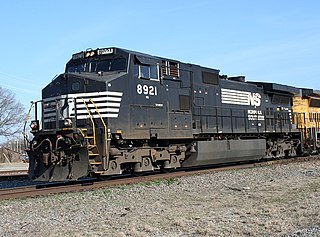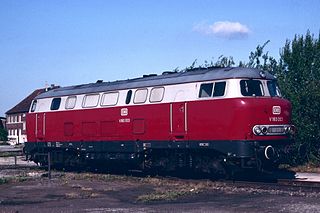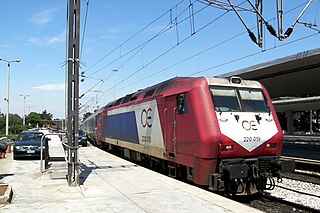| Blue Tiger | |||||||||||||||||||||||
|---|---|---|---|---|---|---|---|---|---|---|---|---|---|---|---|---|---|---|---|---|---|---|---|
 German Blue Tiger in Vacha, Germany (1997) | |||||||||||||||||||||||
| |||||||||||||||||||||||
| |||||||||||||||||||||||
| |||||||||||||||||||||||
| |||||||||||||||||||||||
The Blue Tiger (manufacturer designation: DE-AC33C) is a type of high powered diesel-electric locomotive developed by ADtranz in association with General Electric.
| Blue Tiger | |||||||||||||||||||||||
|---|---|---|---|---|---|---|---|---|---|---|---|---|---|---|---|---|---|---|---|---|---|---|---|
 German Blue Tiger in Vacha, Germany (1997) | |||||||||||||||||||||||
| |||||||||||||||||||||||
| |||||||||||||||||||||||
| |||||||||||||||||||||||
| |||||||||||||||||||||||
The Blue Tiger (manufacturer designation: DE-AC33C) is a type of high powered diesel-electric locomotive developed by ADtranz in association with General Electric.
The prototype was unveiled in 1996.
Initially the axle load was expected to be a light 18 tonnes (17.7 long tons; 19.8 short tons) and the power at ~2,500 kW (3,400 hp). [4] In practice, the German locomotives had an axle load of 21 tonnes (20.7 long tons; 23.1 short tons) (which is normal for this type of diesel locomotive).
General Electric supplied diesel engines and electrical transmission system (which used IGBT-based inverters driving AC traction motors). The rest of the locomotive was built by AdTranz in Kassel.
For the Pakistani export models a 16-cylinder engine was used.
Bombardier took over AdTranz in 2001, subsequently the Blue Tiger locomotive was shown at InnoTrans in 2002 [5] with a view to European orders. The German production models had a mass of 126 tonnes (124.0 long tons; 138.9 short tons) (axle load 21 tonnes or 20.7 long tons or 23.1 short tons) and an engine power of 2,430 kW (3,260 hp).
As of 2009, the class is no longer listed as a production model by Bombardier; GE also lists the family as a former production type. [6] For the European market, Bombardier produces the less powerful diesel variants of the TRAXX family, whilst GE offers variants of its Evolution series for export.
The first orders for the locomotives came from Pakistan Railways in the late 1990s. [7] The locomotives were being built to a gauge of 1,676 mm (5 ft 6 in) and powered by a 16-cylinder engine of 3,300 horsepower (2,500 kW) instead of the 12-cylinder engine used in the prototype and other production models. The first ten were shipped out, the remainder assembled under license in Pakistan. [8] Pakistan Locomotive Series Start From 6001 to 6030.

Twenty locomotives were built to 1,000 mm (3 ft 3+3⁄8 in) gauge in 2003–2004 for KTM. [2] [9] They were designated as "Class 26" (Numbers: 26101 – 26120). [2]
All the locomotives were named after capes in Malaysia.[ citation needed ] In the first decade of operations the locomotives proved more reliable than the Malaysian Class 29 locomotives bought at around the same time. [10]
10 Locomotives were built to 1,435 mm (4 ft 8+1⁄2 in) gauge with a view to leasing or orders.
Various companies have used the locomotives. Initially Karsdorfer Eisenbahngesellschaft GmbH (KEG) [11] was to use 8 units, but went bankrupt in 2005. In 2006, the distribution was: [12]
A working scale model of this locomotive has been produced by the Slovenian company Mehano in N, TT and HO scale.

A diesel locomotive is a type of railway locomotive in which the power source is a diesel engine. Several types of diesel locomotives have been developed, differing mainly in the means by which mechanical power is conveyed to the driving wheels. The most common are diesel–electric locomotives and diesel–hydraulic.

HS4000 Kestrel was a prototype high-powered mainline diesel locomotive that was built in 1967 by Brush Traction, Loughborough, as a technology demonstrator for potential future British Rail and export orders. The locomotive number is a combination of the initials of Hawker Siddeley and the power rating of its Sulzer diesel engine (4,000 hp), making it the most powerful locomotive built by the company.

Prima is a family of railway diesel and electric locomotives built by Alstom. Manufacture of the type commenced in the late 1990s. By 2008, Alstom had reportedly sold 1,750 Prima locomotives. The second generation Prima II was launched in 2009. The Prima H3 diesel/battery hybrid locomotive was launched in 2013.

The GE Dash 9-40CW is a 4,000-horsepower (3,000 kW) diesel-electric locomotive built by GE Transportation Systems of Erie, Pennsylvania, between January 1996 and December 2004. 1,090 were built for Norfolk Southern Railway, as road numbers 8889 to 9978. 53 GE Dash 8-44CWs built to Dash 9 specifications were also built for CSX Transportation, carrying road numbers 9000 to 9052.

Alstom Traxx is a modular product platform of mainline diesel-electric and electric locomotives. It was produced originally by Bombardier Transportation and later Alstom, and was built in both freight and passenger variants. The first version was a dual-voltage AC locomotive built for German railways from the year 2000. Later types included DC versions, as well as quadruple-voltage machines, able to operate on all four electrification schemes commonly used in Europe. The family was expanded in 2006 to include diesel-powered versions. Elements common to all variants include steel bodyshells, two bogies with two powered axles each, three-phase asynchronous induction motors, cooling exhausts on the roof edges, and wheel disc brakes.

The Voith Maxima locomotives are a family of diesel-hydraulic locomotives built by Voith Turbo Lokomotivtechnik GmbH & Co. KG., a subsidiary of Voith.

The Class V 160 is a class of diesel-hydraulic locomotives of the German railways. It is the first variant of the V160 family, built for the Deutsche Bundesbahn for medium/heavy trains.

The DB Class V 60 is a German diesel locomotive operated by the Deutsche Bundesbahn (DB) and later, the Deutsche Bahn AG, which is used particularly for shunting duties, but also for hauling light goods trains. Seventeen locomotives were bought used by the Norwegian State Railways and designated NSB Di 5. Also the Yugoslav Railways bought used units, and designated them JŽ 734; they were subsequently designated Series 2133 by the Croatian Railways.

The Stadler Euro is a class of diesel-electric locomotives built by Stadler Rail for the European market. It is available in two basic variants, the four-axle Euro 3000, and the six-axle Euro 4000. These locomotives are powered by EMD 710 prime movers. A six-axle electric-only variant is marketed as Euro 6000; it is also built for the Iberian gauge.
The Osthannoversche Eisenbahnen AG (OHE) is a Celle based transportation company with railway network in North-eastern Lower Saxony around the Lüneburg Heath area of over 250 km.
The GE Universal Series is a series of diesel locomotives intended for the export market introduced by General Electric in early 1956. General Electric had previously partnered with Alco, producing locomotives for export using Alco's 244 engine, and provided electrical parts for Alco's domestic production. However, with the advent of the Universal Series, GE ended its partnership with Alco and entered the export locomotive market on its own.

The Rhaetian Railway Ge 4/4 III is a class of metre gauge Bo′Bo′ electric locomotives of the Rhaetian Railway (RhB), which is the main railway network in the Canton of Graubünden, Switzerland.

The Rhaetian Railway Ge 6/6 II is a class of heavy metre gauge electric locomotives operated by the Rhaetian Railway (RhB), which is the main railway network in the Canton of Graubünden, Switzerland.

128 001, as registered at Deutsche Bahn, or 12X, as named by its manufacturer AEG Schienenfahrzeuge and its successive owners ADtranz and Bombardier Transportation, is an experimental high-performance electric locomotive built in 1994, which was operated as testbed and test locomotive until 2010. The design of the locomotive featured several technological innovations, including power electronics using new types of semiconductors and water cooling, a new final drive concept, a new bogie concept, and protruding windflaps for improved aerodynamics that gave the locomotive a unique look.

The Rhaetian Railway Ge 2/4 was a class of metre gauge 1′B1′ electric locomotives formerly operated by the Rhaetian Railway (RhB), which is the main railway network in the Canton of Graubünden, Switzerland. Four members of the class are now preserved, with one of them in operational condition.

The Stadler Eurolight is the brand name for a family of 4-axle Bo'Bo' mainline diesel-electric locomotives with sub-20-tonne axleloads for passenger and freight trains produced by Stadler Rail.

The GE PowerHaul is a class of mainline diesel-electric locomotives designed by General Electric. Thirty locomotives were ordered by Freightliner in 2007; the first locomotive was completed in July 2009 at GE's Erie, Pennsylvania, plant.

The Dash 9 Series is a line of diesel locomotives built by GE Transportation. It replaced the Dash 8 Series in the mid-1990s, and was superseded by the Evolution Series in the mid-2000s. Dash 9 series locomotives are some of the most common in the United States.

The Dash 8 Series is a line of diesel-electric freight locomotives built by GE Transportation. It replaced the Dash 7 Series in the mid-1980s, and was superseded by the Dash 9 Series for freight usage and the Genesis Series for passenger usage in the mid-1990s.

The OSE class 220, also known as DE2000 or Marlboro, due to the coloring of the front, reminiscent of the packaging colors of the homonymous tobacco industry, is a series of diesel-electric locomotives operated by TRAINOSE and RCLG and is part of the OSE fleet. It was built in 1998 at the ADTranz factories in Kassel, Germany, as the A.471 series, but in 2003 OSE acquired another batch. The locomotives were put into operation by OSE after the completion of their construction.